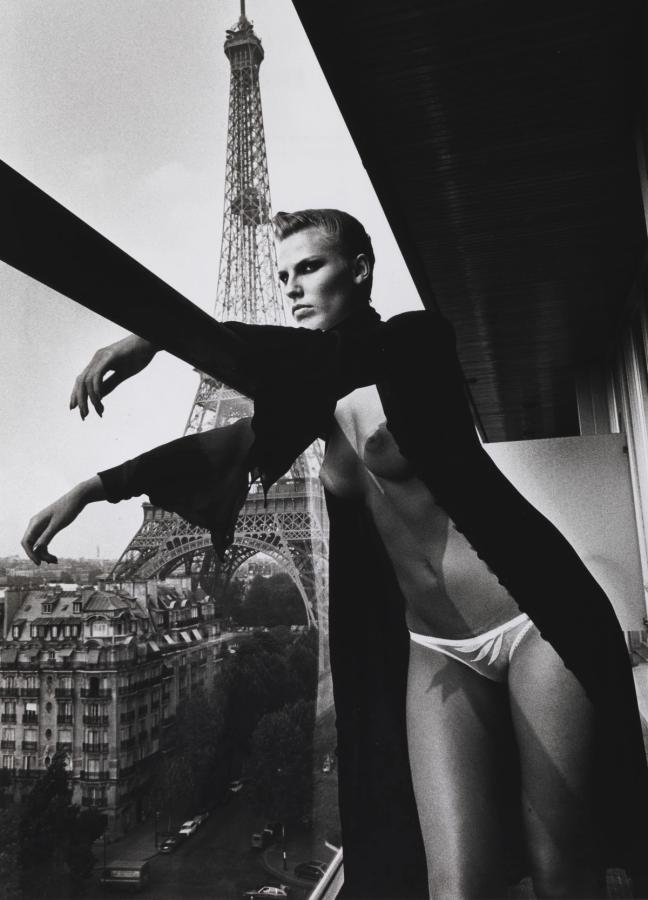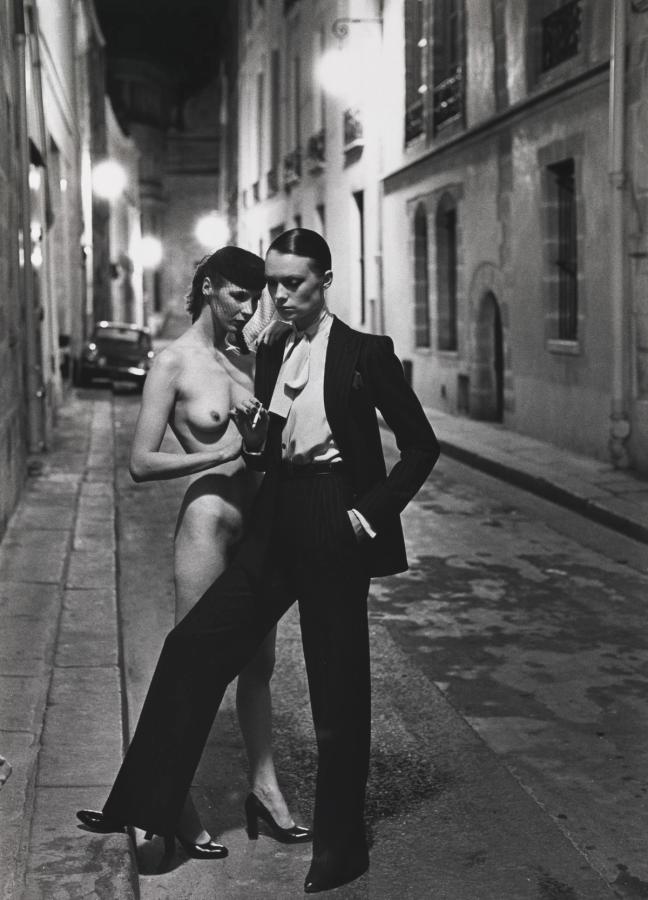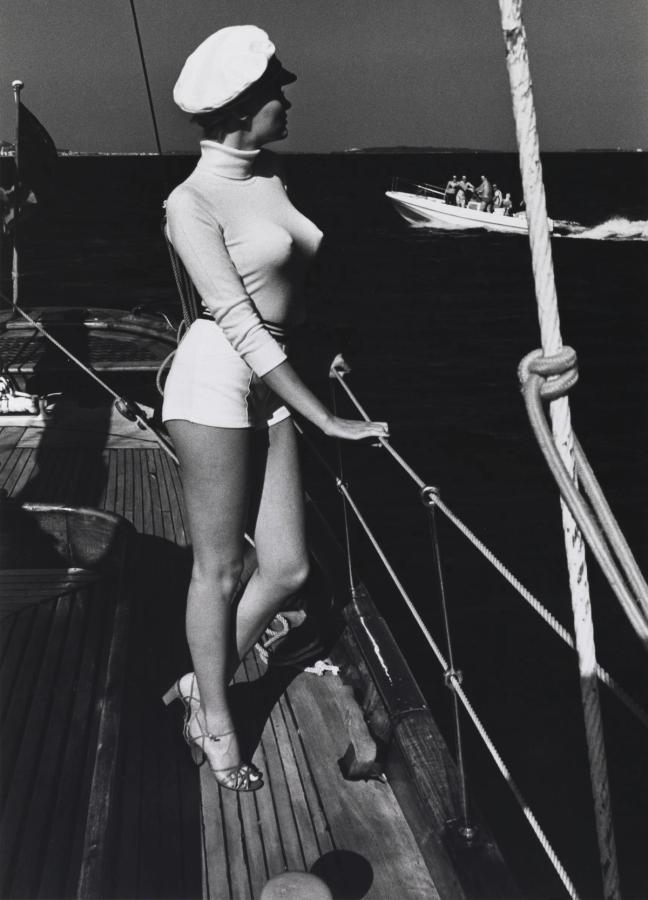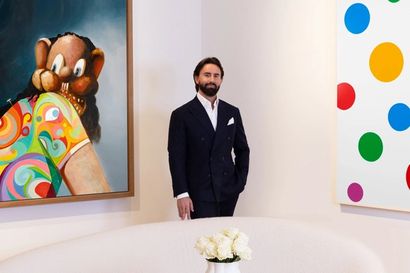The words “high gloss” conjure up an array of connotations, don’t they? Luxury living; sleek sophistication; a sparkling, often unattainable lifestyle set against a backdrop of gleaming floors, floor-to-ceiling windows and swaying palm trees.
In this instance, though, “high gloss” doesn’t refer to a sleekly polished Hollywood hills home. Instead, we’re talking about the Helmut Newton: High Gloss exhibition. It’s currently running at Hamiltons Gallery in the heart of Mayfair, and it celebrates the work of one of the most iconic photographers of all time: Helmut Newton himself.
Featuring a selection of exceptionally rare ferrotyped prints from the 1970s (for any gentlemen who didn’t go to art school and are unfamiliar with the term ‘ferrotyped’, it means putting a glossy surface on a print — hence, ‘High Gloss’), including Woman Examining Man, Elsa Peretti and Rue Aubriot, the exhibition opened last year, to celebrate what would have been Newton’s 100th birthday on 31st October 2020. It’s running until 28th May 2021 — so we’d strongly recommend dashing on down to Mayfair to see these glossy, breathtaking prints for yourself. And if you need a little convincing, allow us to tell you a little about the man himself…

Model and Meccano set, Hilton Hotel, Paris, September 1976, © The Helmut Newton Estate, Courtesy Maconochie Photography. Currently for sale from Hamiltons Gallery.
Newton was born in Berlin in 1920, as Helmut Neustädter — and he started his photographic career aged just 16, with the renowned nude and fashion photographer, Yva. Needless to say, it was a terrifying time to be growing up in Berlin; the Nazi regime was gaining power, and Newton witnessed some of its horrifying effects first hand. “Helmut…lived through the Nazi burning of books in his native Berlin in May 1933 and its terrible aftermath, and he became a determined though not overtly political champion of the principles of freedom of expression and a free press,” wrote Philippe Garner (renowned photography specialist and a personal friend of Newton’s) in the book Helmut Newton: High Gloss by Hamiltons Gallery, 2020.

Une Amie Secrète (Suzy at Home), Paris, 1974, © The Helmut Newton Estate, Courtesy Maconochie Photography
This freedom of expression is indubitably apparent in Newton’s work — but more on this later. Not a moment too soon, Newton escaped Nazi Germany on board a ship at age 18 — and arrived in Australia as a refugee. His photographic career continued to flourish; he opened a small photo studio in Melbourne, before moving to Paris in the 1960s — and it was here that his world-famous career as a fashion photographer really took off. His photographs started appearing in magazines the world over, with celebrity portraits taking the lead: he had countless photos published in Vanity Fair, and his work graced the pages of Vogue on numerous occasions. Indeed, Anna Wintour once described his work as “synonymous with Vogue at its most glamorous and mythic”.
Freedom of expression was at the heart of Newton’s work in myriad ways; and especially when it came to his portrayal of women. He famously challenged society’s perception of female desire, and depicted women with power and command; women in complete control of their environment. He saw the female protagonists in his photographs as wholly liberated, and viewed the nude female body as a photographic symbol of a woman’s strength and autonomy.

Rue Aubriot, Paris, 1975, © The Helmut Newton Estate, Courtesy Maconochie Photography. Currently for sale from Hamiltons Gallery.
Newton celebrated a period of campaigns for gender equality and much-needed sexual liberation through pursuing themes of fetishism, voyeurism and lesbianism in his work. In his book, Helmut Newton: Work (Taschen, 2001), Francoise Marquet wrote that Newton “visualized women who take the lead…women who love and desire whenever and whomever they like, and whatever way they like; women full of health and vigour…enjoying [their bodies], over which they have sole command.”

Winnie on Deck, Off the Coast of Cannes, 1975, © The Helmut Newton Estate, Courtesy Maconochie Photography
Newton made a small number of ferrotyped prints in the 1970s, before developing a collector’s market. His inspiration came from the press and book styles of his 1930s youth, and the lustrous sheen of the printing technique used in the popular illustrated magazines of that era. Newton’s sleek, glossy prints were a challenge to create — ferrotyping is no simple feat — but by the end of the process, each print took on the chic, elegant aesthetic of a high-gloss magazine page: dripping in glamour and oozing charisma with every gleam.
Garner once said that “Helmut valued ferrotyped prints both for their immediate physical quality that so matched the hard, cool chic of his images, and for the significant historical associations they carried for him.”
If you’d like to see these high gloss prints for yourself: be sure to make your way over to Hamiltons Gallery by 28th May. It’s an aesthetic treat for the eyes; and a way to honour one of the most talented photographers ever to grace the camera lens. Trust us: you won’t regret it.
Do you prefer appreciating art in the comfort of your own home? Well, these are the photographic prints you should be investing in this summer…
Become a Gentleman’s Journal member. Find out more here.

Become a Gentleman’s Journal Member?
Like the Gentleman’s Journal? Why not join the Clubhouse, a special kind of private club where members receive offers and experiences from hand-picked, premium brands. You will also receive invites to exclusive events, the quarterly print magazine delivered directly to your door and your own membership card.


